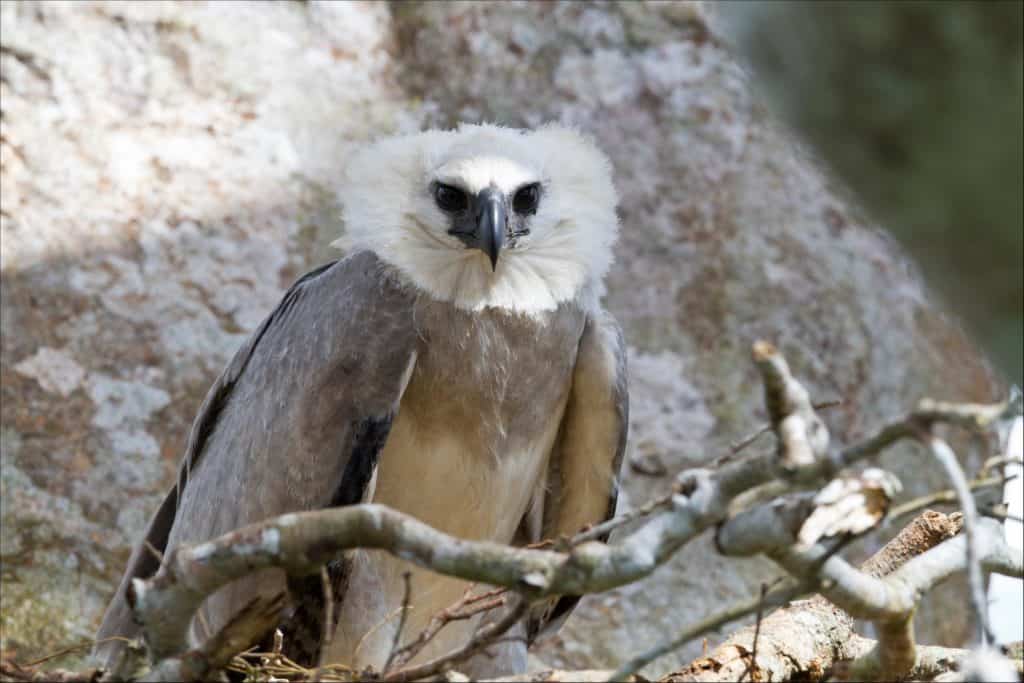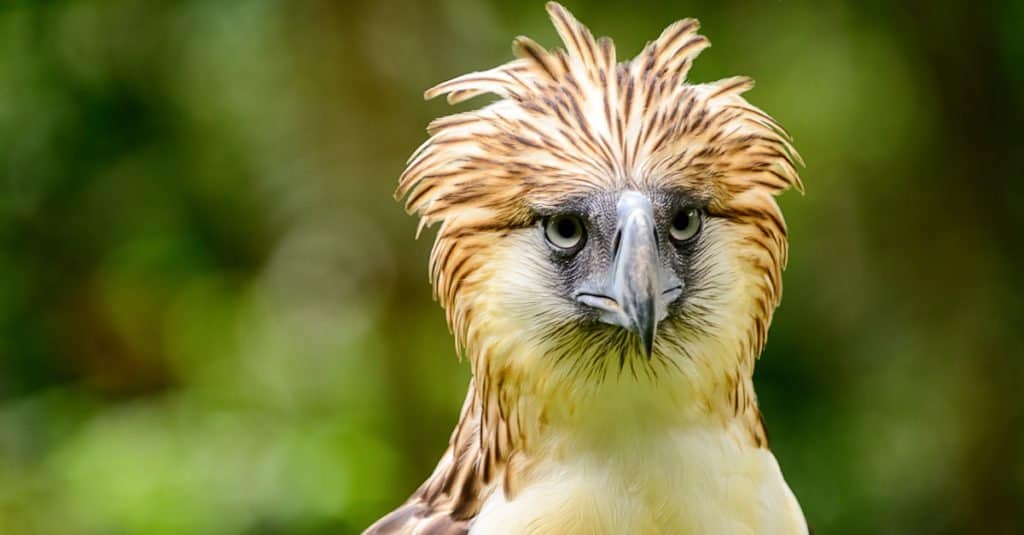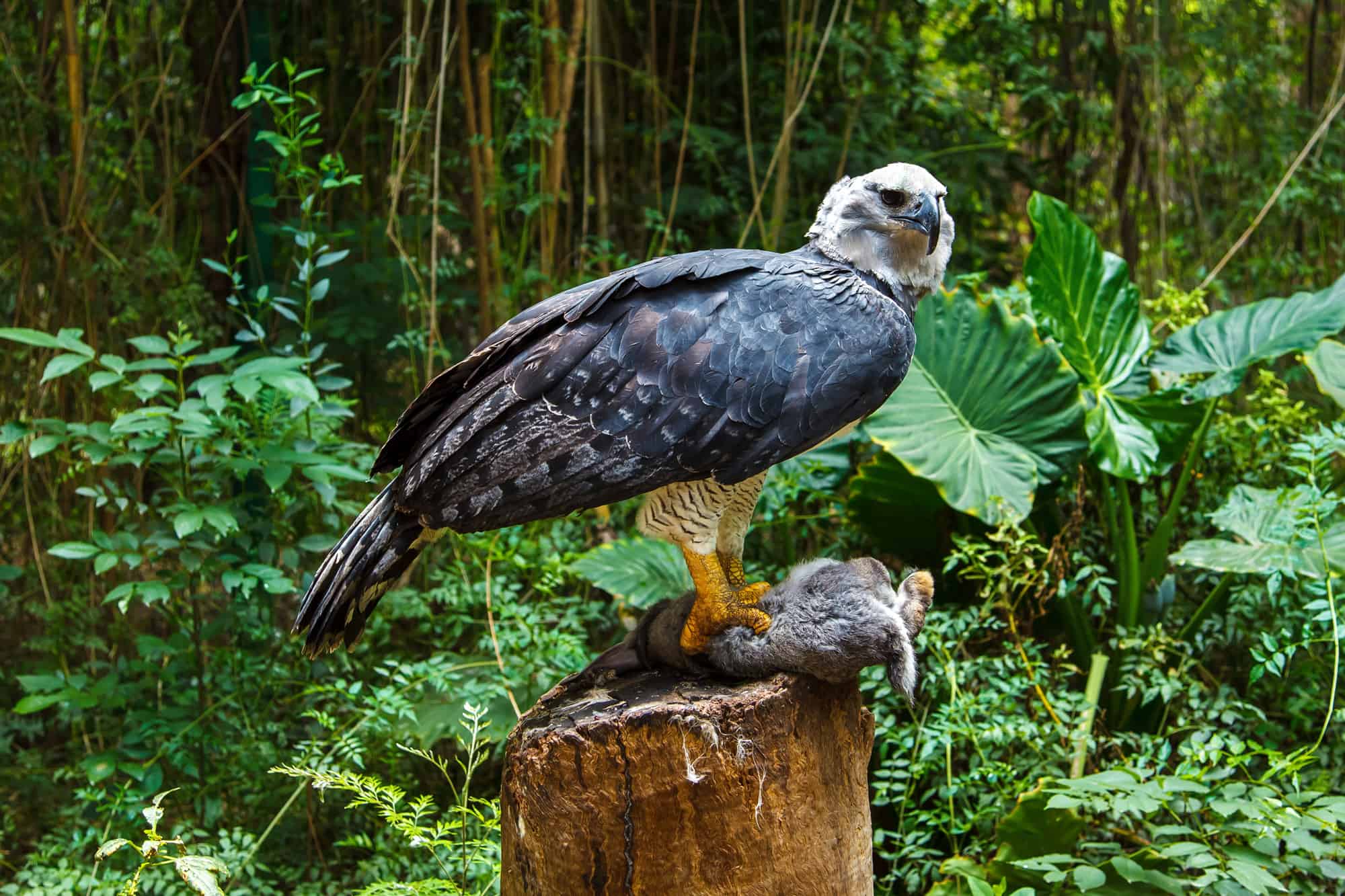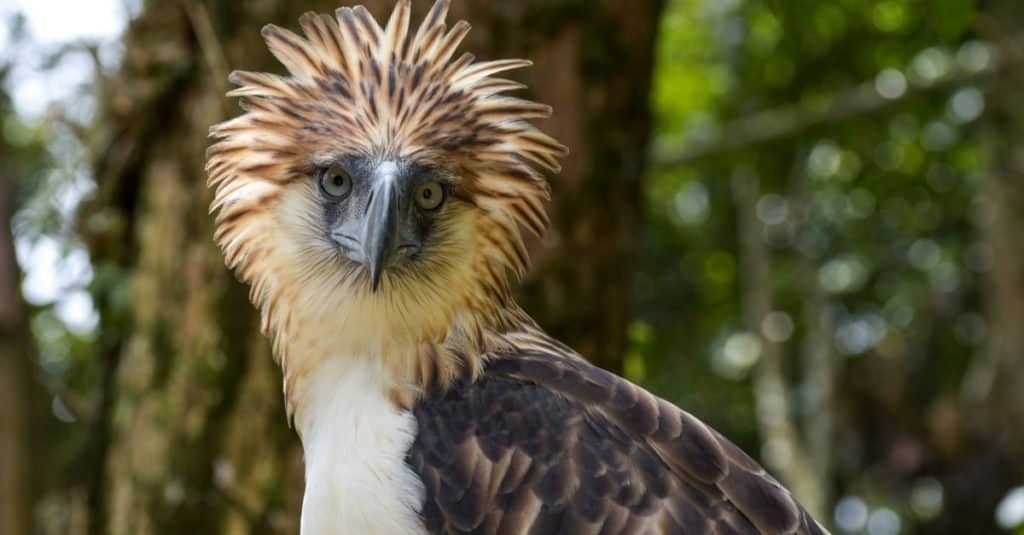Today we are going to learn about the harpy eagle and the Philippine eagle, as well as their similarities and differences between each other. Both magnificent birds are part of the Accipitridae family and share a similar diet. However, they do have many differences between them as well. Let’s read on and find out more about these two wonderful eagles!
Harpy Eagle Vs. Philippine Eagle: A Comparison

| Key Differences | Harpy Eagle | Philippine Eagle |
| Size | 35-40 inches 11-20 lbs. | 2-3 feet, 10-18 lbs. |
| Looks | Gray Head, White Body, Dark Brown Wings, Black Beak | Brown Neck And Back, White Belly And Under Wings, Bluish Gray Beak |
| Wingspan | Up To 6.5 Feet | 6.5 Feet |
| Behavior | Active In Daytime, Hunts By Scanning The Forest Beneath Them | Fast And Agile, Known To Attack Inanimate Objects For Practice |
| Diet | Tree Dwelling Animals In Rainforests | Monkeys, Lemurs, Squirrels, Bats |
| Habitats | Rainforests In Central And South America | Islands And Forests In the Philippines |
| Conservation Status | Not Extinct, But Near Threatened | Critically Endangered |
Key Differences Between Harpy Eagle Vs. Philippine Eagle
The key differences between a harpy eagle and a Philippine eagle are size, appearance, habitat, conservation status, and behavior.
It’s easy to see that both the harpy eagle and the Philippine eagle do share quite a few similarities, but there are also a few key differences. Let’s dissect each one below!
Harpy Eagle Vs. Philippine Eagle: Size

The harpy eagle has a similar size with the Philippine eagle.
©Jeff Cremer/Shutterstock.com
Both the Harpy eagle and the Philippine eagle are very similar in size. They usually do not exceed 3.5 feet and it’s very rare to see them weigh any more than 20 lbs for a harpy eagle and 18 lbs for the Philippine eagle. In fact, these two eagles are some of the biggest birds in the Accipitridae family! Although it has been said that the Philippine eagle is actually the largest bird in the Accipitridae family with its wingspan and that the harpy eagle is larger in terms of weight and size.
Harpy Eagle Vs. Philippine Eagle: Appearance

The Philippine Eagle has a unique look that helps it blend in with the environment.
©Alaz/Shutterstock.com
One of the biggest key differences between the harpy eagle and the Philippine eagle is their appearance. The harpy eagle is a gray and white-bodied eagle with large yellow feet and wings that have black stripes and patterns on them. On its dark head lies a set of feathers that often stand and resemble a crown. Its beak is hooked, and its eyes are large and dark as well.
Philippine eagles are quite different in terms of appearance. These fluffy-looking eagles have feathers that stand all around their head, with a large bluish-black beak in the center of their face. They have white underwings and bellies and dark wings and backs. Looking at these eagles at times is almost looking at a hawk. In fact, these eagles are often called monkey-eating eagles and also called the Philippine hawk-eagle because of their close resemblance.
Harpy Eagle Vs. Philippine Eagle: Wingspan

Harpy eagles have with a wingspan of up to six and a half feet wide, and are considered the most powerful raptors in the Amazon.
©ChepeNicoli/Shutterstock.com
While both the Harpy eagle and the Philippine eagle share a similar wingspan, it also varies depending on the location and habitats of each eagle. The harpy eagle has a wingspan of approximately six and a half feet, however, it varies depending on its location within the rainforest. Some harpy eagles have smaller wingspans in order to adapt to their hunting within the trees of the rainforest, making them more agile and able to swoop down and grab their prey.
The Philippine eagle is actually said to be very large due to its wingspan. Well often times the wingspan of a Philippine eagle is 6 1/2 ft, it has been said that many of these equals have had wingspans that have reached at least 7 ft.
Harpy Eagle Vs. Philippine Eagle: Behavior
A harpy eagle is a bird that is known to sit and perch on very high trees in the rainforest. It usually does this for long periods of time because, during its sitting, it is also scanning and hunting for prey down on the trees of the rainforest. Because of this tactic, this bird is often only active during daylight hours.
Philippine eagles are very well known for its agility. They also use scanning techniques for hunting and are often solitary. When they are hunting from sitting, they are often so still that they almost appear motionless. While they are active during the day as well, they rarely soar when they fly, usually flapping or diving when hunting for tree-dwelling prey.
Harpy Eagle Vs. Philippine Eagle: Diet
While the Harpy eagle and Philippine eagle sometimes share a similar diet, the harpy eagle is known for eating anything that resides on trees in the rainforest in which it inhabits. The Philippine eagle however is a different story. This eagle isn’t called the monkey-eating eagle for no reason. In all actuality, it is said that this eagle primarily eats a variety of monkeys and little to nothing else, though at times it can eat other small birds or lizards. These guys would much rather feast on monkeys and lemurs that reside in the Philippines.
Harpy Eagle Vs. Philippine Eagle: Habitat
Another key difference between the harpy eagle and the Philippine eagle is their habitat and location in the world. The harpy eagle resides in Central and South America, primarily seen within the rainforest of Brazil. It is rarely seen in Central America due to habitat loss but can also be seen anywhere ranging from Mexico to Argentina.
The Philippine eagle is the Philippine’s national bird. It is indigenous to the islands in the forest of the Philippines and has evolved within the country. Although the Philippines have a total of 7,000 islands, critically endangered species can only be found on four of them.
Harpy Eagle Vs. Philippine Eagle: Conservation Status

The Philippine eagle is one of the most endangered bird species in the world.
©Michal Lukaszewicz/Shutterstock.com
Though not extinct, the harpy eagle is a threatened species. Two major challenges to the survival of the harpy eagle are habitat loss and hunting. Sadly, the birds have been wiped out in many locations where they once thrived, including southern Mexico, Central, and South America.
Philippine eagles are in grave danger. Deforestation, hunting, and other human activities have put these rare eagles on the verge of extinction.
Wrapping Up Harpy Eagle Vs. Philippine Eagle

The Philippine Eagle is also known as the “monkey-eating eagle” because of its dietary preference.
©iStock.com/LaserLens
While both the harpy eagle and the Philippine eagle are fascinating to learn about, there is some cause for concern for both birds. While the harpy eagle is not extinct, but near threatened, the Philippine eagle is critically endangered. In fact, only 400 breeding pairs are found on four different islands of the Philippines. It is because of this that killing a Philippine eagle is illegal and can cost an individual up to 12 years in prison if they partake in killing this magnificent bird. Although laws are in place to protect it, shooting, hunting, and deforestation still pose threats to this animal and its distribution.
Thankfully, there are many nonprofit organizations and groups that work to provide recovery and restoration to both species of eagles. They truly are wonderful and amazing creatures that deserve to thrive in the wild!
The photo featured at the top of this post is © NataliaVo/Shutterstock.com
Thank you for reading! Have some feedback for us? Contact the AZ Animals editorial team.






